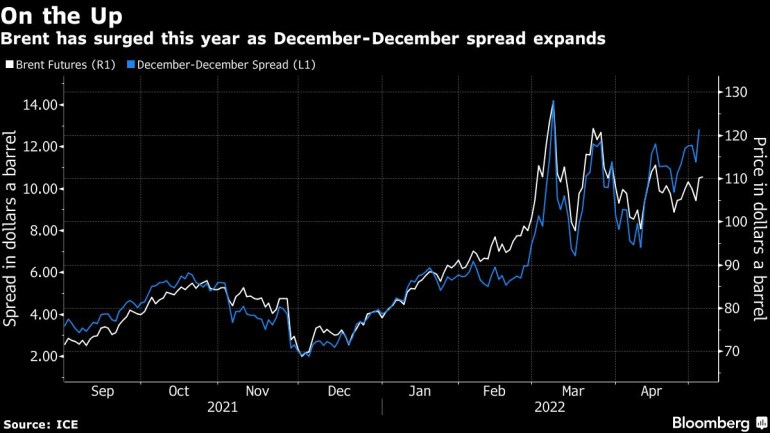Oil climbs to highest since March as US eyes crude purchases
Prices were also supported by OPEC+ ratifying a limited production increase following the European Union’s proposed ban on Russian imports.

Oil jumped to the highest since late March after a report said the U.S. plans to seek bids this fall to replenish its emergency crude reserves.
West Texas Intermediate jumped more than 3% to surpass $111. The Biden administration plans to seek bids for 60 million barrels of crude oil as the first step in a years-long process to replenish America’s shrinking emergency oil reserve, CNN reported, citing an Energy Department official. Prices were also supported by OPEC+ ratifying a limited production increase following the European Union’s proposed ban on Russian imports.
Keep reading
list of 4 itemsWhat you should know about the EU plan to ban Russian oil imports
Europe’s Russia oil embargo risks flaring already hot inflation
Hungary says EU’s Russian oil ban plan lacks security guarantee
The U.S. plans to buy in a tight market with low inventories and low spare capacity, said Giovanni Staunovo, a commodity analyst at UBS Group AG. “That is what the market is now pricing in.”

Oil has surged more than 40% this year as the war disrupted flows, inflation picked up and central banks — including the U.S. Federal Reserve — started tightening policy. The dollar was higher Thursday, adding a headwind to crude, after the Fed hiked interest rates by the most since 2000.
The EU said this week it will ban Russian crude over the next six months and refined fuels by year’s end to increase pressure on President Vladimir Putin over his invasion of Ukraine. The bloc also is targeting insurers in a move that could dramatically impair Moscow’s ability to ship oil around the world.
Prices:
- WTI for June delivery added 2.7% to $110.80 a barrel at 9:18 a.m. in New York.
- Brent for July settlement rose 3% to $113.45 a barrel.
At present, Russia’s oil exports are running at a record pace as Moscow manages to reroute cargoes previously sent to the U.S. and elsewhere to alternative buyers, especially in Asia, according to the note.
The EU aims to conclude the sanctions package by the end of the week, or May 9 at the latest, according to diplomats. To get the curbs over the line, the bloc needs to address concerns from Hungary and Slovakia on phaseout timing, and queries from Greece on banning transport of oil between third countries.
Further supporting markets, OPEC and its allies will nominally increase production by 432,000 barrels a day in June. However, OPEC only managed an increase of just 10,000 barrels a day in April, indicating the difficulty the group is having in lifting output in line with its plan.
With all the potential supply constrictions, oil markets remain in backwardation, a bullish pattern marked by near-term prices trading above longer-dated ones. Among key differentials, the spread between Brent’s two nearest December contracts was above $13 a barrel Thursday. That’s more than triple the gap at the start of the year.
(Previous version corrected month to April in second paragraph.)